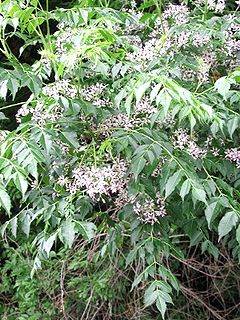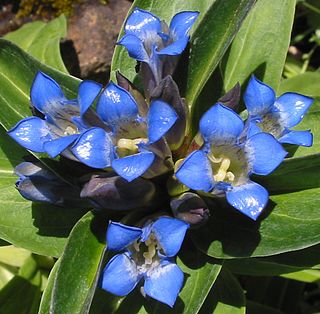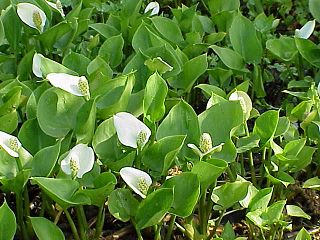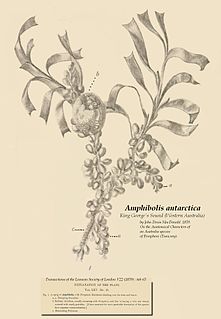
Asterales is an order of dicotyledonous flowering plants that includes the large family Asteraceae known for composite flowers made of florets, and ten families related to the Asteraceae.

The Ericaceae are a family of flowering plants, commonly known as the heath or heather family, found most commonly in acid and infertile growing conditions. The family is large, with c. 4250 known species spread across 124 genera, making it the 14th most species-rich family of flowering plants. The many well-known and economically important members of the Ericaceae include the cranberry, blueberry, huckleberry, rhododendron, and various common heaths and heathers.

The flowering plants, also known as angiosperms, Angiospermae or Magnoliophyta, are the most diverse group of land plants, with 64 orders, 416 families, approximately 13,164 known genera and c. 369,000 known species. Like gymnosperms, angiosperms are seed-producing plants. However, they are distinguished from gymnosperms by characteristics including flowers, endosperm within the seeds, and the production of fruits that contain the seeds. Etymologically, angiosperm means a plant that produces seeds within an enclosure; in other words, a fruiting plant. The term comes from the Greek words angeion and sperma ("seed").

Meliaceae, the mahogany family, is a flowering plant family of mostly trees and shrubs in the order Sapindales.

In botany, a bulb is structurally a short stem with fleshy leaves or leaf bases that function as food storage organs during dormancy.

The Santalales are an order of flowering plants with a cosmopolitan distribution, but heavily concentrated in tropical and subtropical regions. It derives its name from its type genus Santalum (sandalwood). Mistletoe is the common name for a number of parasitic plants within the order.

Gentianales is an order of flowering plants, included within the asterid clade of eudicots. It comprises more than 16,000 species in about 1,138 genera in 5 families. More than 80% of the species in this order belong to the family Rubiaceae.

The dicotyledons, also known as dicots, are one of the two groups into which all the flowering plants or angiosperms were formerly divided. The name refers to one of the typical characteristics of the group, namely that the seed has two embryonic leaves or cotyledons. There are around 200,000 species within this group. The other group of flowering plants were called monocotyledons or monocots, typically having one cotyledon. Historically, these two groups formed the two divisions of the flowering plants.

Fagaceae is a family of flowering plants that includes beeches and oaks, and comprises eight genera with about 927 species. The Fagaceae are deciduous or evergreen trees and shrubs, characterized by alternate simple leaves with pinnate venation, unisexual flowers in the form of catkins, and fruit in the form of cup-like (cupule) nuts. Their leaves are often lobed and both petioles and stipules are generally present. Leaf characteristics of Fagaceae can be very similar to those of Rosaceae and other rose motif families. Their fruits lack endosperm and lie in a scaly or spiny husk that may or may not enclose the entire nut, which may consist of one to seven seeds. In the oaks, genus Quercus, the fruit is a non-valved nut called an acorn. The husk of the acorn in most oaks only forms a cup in which the nut sits. Other members of the family have fully enclosed nuts. Fagaceae is one of the most ecologically important woody plant families in the Northern Hemisphere, as oaks form the backbone of temperate forest in North America, Europe, and Asia and one of the most significant sources of wildlife fodder.

Ranunculales is an order of flowering plants. Of necessity it contains the family Ranunculaceae, the buttercup family, because the name of the order is based on the name of a genus in that family. Ranunculales belongs to a paraphyletic group known as the basal eudicots. It is the most basal clade in this group; in other words, it is sister to the remaining eudicots. Widely known members include poppies, barberries, and buttercups.

The Oxalidaceae, or wood sorrel family, are a small family of five genera of herbaceous plants, shrubs and small trees, with the great majority of the 570 species in the genus Oxalis. Members of this family typically have divided leaves, the leaflets showing "sleep movements", spreading open in light and closing in darkness.

The Portulacaceae are a family of flowering plants, comprising 115 species in a single genus Portulaca. Formerly some 20 genera with about 500 species, were placed there, but it is now restricted to encompass only one genus, the other genera being placed elsewhere. The family has been recognised by most taxonomists, and is also known as the purslane family; it has a cosmopolitan distribution, with the highest diversity in semiarid regions of the Southern Hemisphere in Africa, Australia, and South America, but with a few species also extending north into Arctic regions. The family is very similar to the Caryophyllaceae, differing in the calyx, which has only two sepals.
Monocarpic plants are those that flower, set seeds and then die. The term was first used by Alphonse de Candolle. Other terms with the same meaning are hapaxanth and semelparous. The antonym is polycarpic, a plant that flowers and sets seeds many times during its lifetime; the antonym of semelparous is iteroparous. Plants which flower en masse (gregariously) before dying are known as plietesials.

Calla lily is a common name for a type of plant.
It may specifically refer to:

Sida is a genus of flowering plants in the mallow family, Malvaceae. They are distributed in tropical and subtropical regions worldwide, especially in the Americas. Plants of the genus may be known generally as fanpetals or sidas.

Rigiopappus is a genus of North American plants in the aster tribe within the sunflower family. It is closely related to genus Pentachaeta.

Polygonum basiramia is a rare species of flowering plant in the knotweed family known by the common names wireweed, hairy wireweed, purple wireweed, and Florida jointweed. It is endemic to Florida in the United States, where it is limited to the central ridges of the peninsula, including the Lake Wales Ridge. It is threatened by the loss and degradation of its habitat. It is a federally listed endangered species of the United States.

Polygonum dentoceras is a rare species of flowering plant in the knotweed family known by the common names sandlace, woody wireweed, and Small's jointweed. It is endemic to Florida in the United States, where it is limited to the central ridges of the peninsula, including the Lake Wales Ridge. It is threatened by the loss and degradation of its habitat. It is a federally listed endangered species of the United States.


















